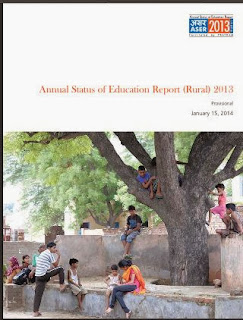[MLE] Release of ASER Report - also: Implications for English teaching
Dear multilingual Education friends,
Every year the ASER report provides a great source of data with regards to realities of primary education in rural India. The ASER press release states:
Every year the ASER report provides a great source of data with regards to realities of primary education in rural India. The ASER press release states:
While reflecting on the data, Rukmini Banerji, the director of ASER, wrote in the Hindustan Times an article on "When and how English should be taught in schools". Some quotes:Every year, ASER finds out whether children in rural India go to school, whether they can read simple text and whether they can do basic arithmetic.
Nationally, the proportion of all children in Std. V who can read a Std. II level text remains virtually the same since 2012, at 47%. This proportion decreased each year from 2009 to 2012, dropping from 52.8% in 2009 to 46.9% in 2012. Among Std. V children enrolled in government schools, the percentage of children able to read Std. II level text decreased from 50.3% (2009) to 43.8% (2011) to 41.1% (2013). Over the last three years, there has been a steady increase in the provision of libraries in schools that have been visited. The All India figure for schools with no library provision
dropped from 37.4% in 2010 to 22.9% in 2013.
Given the changing priorities in education policy and the shift in focus to learning outcomes, we hope that in the next few years there will be much better news to report on children’s learning.
The figures indicate that about half of all rural children in Class 8 can read a set of simple sentences and of those who can read about three-fourths can explain the meaning of what they have read. - See more at: http://www.hindustantimes.com/comment/analysis/when-and-how-english-should-be-taught-in-schools/article1-1166370.aspx#sthash.lllnv1NR.dpuf
When and how English should be taught in schools
When and how English should be taught in schools
When and how English should be taught in schools
When and how English should be taught in schools
The figures indicate that about half of all rural children in Class 8 can read a set of simple sentences [in English] and of those who can read about three-fourths can explain the meaning of what they have read.
Time and again, the NCF 2006 focus group paper on the teaching of English dwells on the need to help children learn their first language well. Looking at our own realities, it is essential that we must develop our own ways of bridging between languages and creating our own processes for language development within and across languages
More often than not, the weakness in learning a new language has less to do with the new language and more to do with lack of capability, competence and confidence in the original language. Second, if children have print material around them — books, stories, posters, newspapers, slogans — the more they learn how to deal with print. This is true regardless of the language. (ASER 2012 figures indicate that apart from textbooks, less than 20% of rural households have any material to read.)
We have found that children respond well to texts that have both languages interspersed. This is different from bilingual texts where both languages are placed side by side.
We have found that children respond well to texts that have both languages interspersed. This is different from bilingual texts where both languages are placed side by side. - See more at: http://www.hindustantimes.com/comment/analysis/when-and-how-english-should-be-taught-in-schools/article1-1166370.aspx#sthash.lllnv1NR.dpufWe must encourage children to have fun in using language differently and appropriately in different situations for different purposes. Serious investment in building strong foundations in language skills will reap rich dividends in all the languages that children use. Whether Hindi, English or any other language, our approach to children in our fertile language landscape must be connected to our realities and suited to our condition, capabilities, needs and uses.
Good thoughts on dealing with the multilingual realities here.
Regards,
Karsten
Regards,
Karsten
--
Document
Disclaimer: This mailing list is an informal way to share mother tongue based multilingual education (MLE) related information. The sender neither claims credit or responsibility for the reports and events shared through this mailing list. Subscribing or unsubscribe by writing "[MLE] Subscribe" or "[MLE] Unsubscribe" in the subject-line and send a message to: karsten_van_riezen@sil.org. Any contributions or suggestions are welcome.
|
